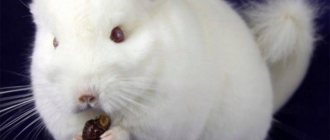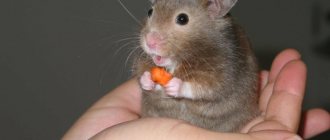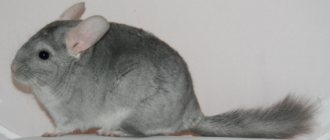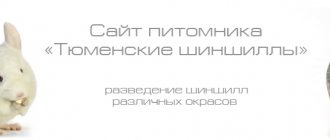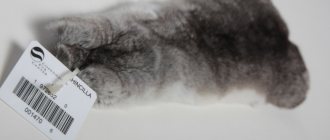Many believe that chinchilla breeds are fiction, and that the animals can be exclusively gray, the way they are most often seen in pet store windows and in photos on the Internet. However, this opinion is wrong. Breeders have been working for decades to ensure that the breeds and shades of these funny rodents only increase.
Below we will introduce you to the varieties of chinchilla colors and their breeds offered in nurseries.
Chinchilla breeds
These domesticated rodents are divided into two varieties, which have their own characteristics in the structure of the body and the length of the tail:
- Large short-tailed Peruvian chinchillas came to us from Bolivia and Argentina. These places are their homeland, and there they live in the wild, but only in protected areas, since local residents exterminate them for their valuable fur. In addition to nature reserves, they are also grown on specialized farms. Short-tailed chinchillas not only have dense fluffy fur, but also a fairly strong body. Standing on its hind legs, the animal reaches a height of up to 40 centimeters and weighs about 800 grams. The tail of large rodents is short, covered with stiff, short hair.
- Coast long-tailed chinchillas are common in Chile. They have a small body and a long tail covered with dense fur. Their weight does not exceed 700 grams.
Both chinchilla breeds are light gray in color. However, thanks to the efforts of breeders, long-tailed chinchilla rodents can now boast a huge variety of shades of their magnificent skin.
Angora chinchilla
One of the subspecies of long-tailed animals is the Angora royal chinchilla. It was not bred artificially. The rodent appeared thanks to the efforts of nature itself.
The animal was first noticed in the sixties of the last century. But he was included in the breed directory only in 2001. It is extremely difficult to breed this subspecies in artificial conditions, since the children from the male and female of this breed of chinchillas do not always turn out to have long hair; they often have short hair. It is for this reason that breeding Angora dogs requires the breeder not only to be professional, but also to carefully select pairs.
Angoras have silky long fur and a luxurious tail. In addition, they have long hair on their heads and paws. This breed of chinchilla has a flattened muzzle, which is why people call them Persian. The animals themselves are black, blue, diamond and purple.
“Angora chinchillas are the most expensive of all. The price of one individual is over 50 thousand rubles. The domestic animal has such valuable fur that the high cost of rodents has remained so for decades.”
Dwarf chinchilla
Mini chinchillas are also a natural genetic mutation. These animals have a small body, short legs and a bushy tail. The weight of rodents does not exceed 300 grams.
Dwarf domestic chinchillas give birth to the same cubs as their ordinary counterparts, so childbirth is difficult to endure. In most cases, babies do not survive. The animal must be under the supervision of a veterinarian throughout pregnancy. The shades of these cute animals can be different.
Main differences between the species
In total, there are 2 types of chinchillas found in nature - short-tailed and long-tailed. They have absolutely the same habits and character. And they differ only in appearance:
- The long-tailed chinchilla is characterized by higher fertility. It is found in Chile, in the mountain ranges located on the Pacific coast. It is further divided into 2 subspecies – mountain and coastal. Mountain animals live exclusively on rocks, at an altitude of 3-5 thousand meters above sea level. Coastal ones do not rise above 2 thousand meters.
- The habitat of the short-tailed chinchilla is Chile, Argentina, Bolivia. They live only high in the mountains. Therefore, they have thicker, dense fur, which is why they are on the verge of extinction. They also differ from their long-tailed relatives in their stocky body, short neck and strong head. It is very rare to encounter a short-tailed chinchilla in its natural habitat.
All other species were bred artificially using breeding work with long-tailed chinchillas. The result is about 100 breeds, which differ mainly in color. And only 2 varieties have several more distinctive features:
- Angora chinchilla . It differs from all other species in its fluffy long fur and spreading tail. It also has a slightly flattened muzzle. The most expensive breed, since the necessary characteristics are not always inherited during breeding. And only experienced breeders are able to produce long-haired babies.
- Dwarf chinchilla . The main difference is the size. If ordinary chinchillas weigh 600-800 g, then dwarf chinchillas weigh 300-400 g. Otherwise, they are similar to the rest of their relatives.
It is worth noting that dwarfism is not the result of the work of breeders, but a natural mutation. Accordingly, the cubs of such chinchillas are born of normal sizes. As a result, dwarf females often die during childbirth. Therefore, these babies are absolutely not suitable for breeding.
Varieties of colors
Since chinchillas have a lot of enemies in the wild, for their own safety, rodents have a light gray color, inconspicuous among rocky terrain.
Gray is the standard color for these cute animals, but artificially bred chinchilla breeds come in a wide variety of shades. Among them there are black, beige, white and even blue tones of chinchilla fur. Therefore, it is now extremely difficult to imagine that chinchillas originally had only gray colors.
All shades of chinchilla fur can be grouped as follows:
- gray or agouti: two shades that are standard;
- white, having different saturation and an admixture of beige and pinkish;
- brown or pastel, available in a full range of colors up to dark chocolate;
- black with varying degrees of saturation;
- purple, pink and sapphire.
In addition, it should be taken into account that fur colors differ not only in color, but also in:
- recessive. When a chinchilla is only a carrier of the gene responsible for the shade of its coat.
- dominant. When the color is already there and visible from birth.
When breeding rodents, it is extremely important to know what recessive color the male chinchilla and the female selected for mating have.
Other colors
In addition to the above, there are other colors of chinchillas, photos of which you can see below. They are recessive, so such individuals are rare and highly prized. These include:
- sapphire;
- albino;
- foggy;
- charcoal.
The fur of those with the Sapphire color is gray, but has a pronounced blue tint, and the animal’s belly is white. The peculiarity of such animals is that their coats remain colored throughout their lives; they do not darken with age.
Albinos lack any pigment, so their fur is snow-white, without mosaic spots or transitions, and their eyes are red.
Rodents with a foggy (hazy) color have a gray coat on which a blurred pattern can be distinguished; it can be a tone lighter or darker than the main one. The animal's eyes are dark.
Rodents with gray color
Gray standard
Gray chinchillas are found both in the wild and in captivity.
Breeders divide them according to the color itself and its depth. Gray chinchillas are:
- light gray;
- medium gray;
- dark;
- moderately dark;
- extra dark.
Gray coloring is standard for chinchillas living in the wild and in domestic environments. The back of rodents is dark, the sides are light, and the belly is white. The wool has two shades. It is gray-blue at the base and black at the ends of the hairs.
Individuals of gray shades, unlike other rodents, are distinguished by very good health. In addition, the age of chinchillas of this shade to bear their first offspring is much lower than that of other subspecies. They can be crossed with absolutely any variety. Rodents have fur that is delicate and soft to the touch.
Light gray
Light gray fur with a silver tint looks very impressive. These chinchillas have a light chest, belly and limbs.
Medium gray
The most common color. The body of the animals has a uniform gray tint, the fur on the stomach, limbs and chest is light.
Dark
The fur has a gray tint with a bluish tint. The belly and chest of rodents are light, standing out well against the background of the rest of the fur.
Moderately dark
The fur of rodents has a dark gray tint, turning into ashy on the face, limbs and sides. Chinchillas have a bluish-white belly.
Extra dark
Many breeders prefer charcoal gray chinchillas with light sides and chest. The belly of this subspecies of rodents is almost white.
Gray standard (Standart)
The gray chinchilla is one of the most common species. This is explained by the fact that this color is natural. The Incas began breeding rodents of exactly this color many centuries ago. They called them "chincha", which means "bug". All other colors were developed artificially much later.
Their belly is white, and the rest of the fur is grayish, with a smooth transition from light to darker. There are:
- Light.
- Average.
- Dark standard.
The gene responsible for this coloration is called agoti. It is thanks to him that the smooth play of fur is created. It ensures the presence of pigment granules in certain areas, so each hair has a black or bluish lower part, a snow-white middle part, and a black tip.
Gray individuals are larger and stronger than others and reach maturity early. This color is a simple dominant one; crossing gray individuals with any others is allowed.
Chinchillas with light colored fur
Chinchillas with a white coat simply look luxurious and elegant. They have a number of unusual shades.
White Wilson
Chinchillas have white fur mixed with white or beige. You can purchase such an animal at a nursery or from breeders at home. The color is in demand among connoisseurs of these rodents.
Albino
These chinchillas do not have color pigments at the genetic level, so they have a snow-white tint and a red iris.
White lova
Chinchillas have white fur with a slight cream tint and dark ruby eyes.
White velvet
These animals have light fur that is velvety to the touch. Boy chinchillas often have a silver tint, while girls have a beige tint. In addition, they have distinctive gray spots on the head and limbs.
White-pink
The description of these chinchillas is as follows. Animals with milky white fur, pinkish ears and beady black eyes. However, there are representatives of this species that have a pink stripe on the back.
Pink White
White-pink is a very beautiful color that carries three genes:
- White.
- Beige.
- Standard.
And it is the first gene that is responsible for the manifestation of mosaic pattern: gray-brown spots on the surface of the fur. Sometimes there are beige individuals with whitish spots or stripes. The ears of white-pink individuals are pinkish, sometimes there are freckles, and the eyes are bright or dark red.
Due to the presence of a lethal gene, such animals cannot be paired. With the exception of this feature, otherwise such individuals will be excellent partners for rodents with other coat colors.
Animals with beige fur
The main shade of these rodents is pastel. However, it has several variations. Additionally, the older the chinchilla, the darker its fur will be. It can be brown, red or beige. This type of rodent can be crossed.
Homobeige
This species of rodent has light beige fur with uniform coloring and pink ears. For this shade, single dark hairs are acceptable.
Heterobeige
In these rodents, on the contrary, the color is uneven. The entire coat is beige, and the undercoat and ends of the hairs are brown. When choosing a chinchilla, you should pay attention to the color distinction between the rest of the body and the belly.
Beige tower
The color of the fur of these animals varies from light to dark beige, which is combined with a brown pattern located along the spine.
Wellman beige
The chinchilla has light beige fur, light ears and dark eyes.
Beige Sullivan
Rodents have rich beige fur and red eyes.
Brown velvet
The basic fur color of these animals is beige, while the back and head have a chocolate tint, and the belly is sandy.
Blue diamond (sapphire violet, violet sapphire)
Purple sapphire or blue diamond (Blue Diamond)
Blue Diamond, Violet Sapphire is perhaps the most beautiful and rare mutation of them all.
This is a double recessive mutation.
There are only a few people in Denmark, the Netherlands, England and Norway who breed this color. Tellus Chinchilla, SantiagoFarm are some of these nurseries. Now in Russia there are breeders who are working on obtaining the Blue Diamond, these are Star Chinchillas and Natalya Volkova and some other breeders.
This is a long-term and very labor-intensive process, but the result exceeds all expectations. Blue Diamond is obtained from crossing purple and sapphire chinchillas in several stages, i.e. this color contains 2 violet and 2 sapphire genes at the same time. This means that when crossing a Blue Diamond with a simple standard, all babies will be standard carriers of violet and sapphire at the same time. Blue Diamond chinchillas are a soft blue color with good contrasts, the color is similar to metallic.
Some believe that there is a separate blue diamond gene, but this is a big misconception among inexperienced and young breeders - there is no such gene. A blue diamond is sapphire and violet in one. Experienced and competent breeders do not identify this gene as a separate one, but if a chinchilla carries both the violet and sapphire gene, they can write it as “carrier of blue diamond”, this is equivalent to “carrier of sapphire and violet”.
Now “colored diamonds” have begun to appear in the world - beige, white, ebony.
Source
Chinchilla ebony
These animals are distinguished not by a certain color, but by the quality of their skin. If you bring the rodent to the light, the fur begins to shine and shimmer. The color palette of such chinchillas is quite diverse.
Homoebony
Chinchillas of this color have black fur and black eyes. Also, the color of these animals has a second name - charcoal.
Heteroebony
These rodents combine two shades: black and gray. They are very impressive and often take first place at exhibitions.
White ebony
Chinchillas have snow-white fur with a black coating at the ends of the hairs. The limbs, head and base of the tail may have a beige tint.
Chinchillas with dark fur
These rodents include black velvet chinchillas with rich black fur and a white belly.
Black velvet
This color combines black and white. The animals have a black body and tail, and a white belly. This contrast looks very impressive and the clearer the color boundaries, the higher the price of a chinchilla and the more valued the breed is.
This species of rodent was bred in the 60s of the last century. Breeders believe that the dark skin is evidence of the high quality of the breed. Chinchillas may have light stripes on their limbs, a charcoal mask, and dark fur on their heads.
The older a rodent gets, the more pronounced its breed characteristics become. Since the black fur gene is lethal, crossing with representatives of your own breed is unacceptable; black chinchillas can only be mated with rodents of other colors.
Genomic features
Connoisseurs of black animals affectionately call them “a touch of velvet” or “black velvet.” The black chinchilla, the characteristics of the genotype of which have already been sufficiently studied, has some genetic characteristics. This color is considered heterozygous, that is, two genes are present in one allele - dominant (black) and recessive.
Black chinchillas have one negative feature - their color contains the so-called “lethal gene”. This leads to the fact that as a result of crossing two chinchillas with a black gene, the embryos either die during development or do not develop at all.
Rare colors of chinchillas
The most expensive and valuable animals have a rare, very beautiful color. Breeders managed to breed several breeds, looking at which it is simply impossible to contain delight.
Violet
Rodents have a light lilac coat, contrasting with a white belly. The ears and nose of the animals have a purple tint. When crossed, the unusual color is passed on only in the first and second generations. Purple chinchillas mature late and can mate only after one and a half years.
Sapphire
The fur of these animals can be either bluish-gray or light blue with a light graphite coating. Chinchillas have a white belly and black eyes. The animals are among the most expensive and sought after among breeders. The unique coloring does not appear immediately, but only by 8 months. To purchase a real sapphire chinchilla, it is better to purchase the rodent from a licensed nursery.
Blue Diamond
Chinchillas have light blue fur with a metallic sheen. There is a dark stripe along the ridge and head.
White and pink diamond
One of the rare colors is pearl with a pinkish tint. The color of such chinchillas' fur resembles pearls. The exception is the ears, which have a pinkish tint. The pearl gene is lethal, so representatives of the same breed cannot be crossed. Chinchillas of other colors are suitable for mating.
Violet
Violet is a very beautiful rodent, the species carries a white gene and two purple ones. Often confused with Wilson White, but the main difference is in the coloring of the spots; Wilson’s are gray.
In normal light, the fur coat of these individuals has a purple tint, which imparts a special charm due to its sparkle. Under artificial light it becomes steel gray. The belly, like the standards, is snow-white. There are White and Gray Violet. The first may have various purple spots on the fur, their shade most noticeable at the tip of the tail.
The quality of the coloring is characterized by an even, bright rosette, which is ensured by the color of the base of the hairs in a gray-violet color, the light middle part and the tip from light purple to bright purple. The color intensity of an adult animal’s coat can be determined at birth, and the final color appears by the seventh or eighth month.
When choosing a pair for your purple pet, consider the following recommendations:
- to get a beautiful pet, choose light standards;
- the purple gene is passed on in both the first and second generations;
- due to the recessivity of violet, when crossed with non-violet, the offspring will only be a carrier.
Animals with purple fur reach maturity late. But despite the ability to reproduce only after 14-18 months, such animals are very popular.
Breeding chinchillas
Thanks to the wide variety of rodent colors, breeders have plenty of opportunities to develop new breeds. Crossbreeding itself is a unique process, because you never know whether the babies may display a recessive gene from one of the parents. However, there are also restrictions on mating individuals. For example, there are two lethal genes: black and white. They cannot be combined, otherwise not only the babies, but also the female herself may die while carrying them.
"Note! To carry out successful crossbreeding, all breeders have passports for their animals. The documents indicate what genes their pets have, and also indicate the possible color of their future babies.”
Genetic color calculator for chinchillas
The colors of chinchillas are very diverse. How to breed an individual of the desired color? Understanding the complex interweaving of pet genes can be quite difficult. A tool such as a genetic calculator comes to the aid of a chinchilla breeder. Using a genetic calculator, you can determine which color offspring is most likely to be born.
So, using this calculator, you can calculate that a Homoebony mother and a Homoebony dad will have almost 64% probability of producing Gomoebony cubs. There is a 22% chance that their babies will have the Extra-Dark Ebony color. The possibility of these parents having Ebony-dark babies is 10%. And in only 4% of cases, such a couple gives birth to Ebony-light and Ebony-medium cubs.
Results
Breeding chinchillas is a very profitable business. However, in order to become an experienced breeder, you should take into account not only the breeds of chinchillas and their colors, but also know all the intricacies of the care and nutrition of these magnificent animals.
Gray and beige rodents are easier to breed, they are more common, and their babies are cheaper than, for example, sapphire and purple ones. Crossing and breeding chinchillas is an extremely complex process, so it needs to be approached wisely and only done by those people who are truly interested in it. You should not do this for the sake of banal profit, since nothing good will come from such a business.
Not only breeders, but also scientists around the world are engaged in breeding new breeds. They are driven to this by the popularity of rodents not only as pets, but also by their breeding as specimens to obtain valuable fur.
Keeping a chinchilla at home is not very easy, but it is worth it. The animals love their owners very much and treat them with tenderness and love. Breeders advise purchasing chinchillas in pairs, because there is nothing more pleasant than watching their games, affection, love and friendship, which a person can only envy.
Lifestyle
The biology of chinchillas in natural habitats has been little studied; basic data on behavior, reproduction, and physiology are obtained in artificial conditions. Most of the data relates to long-tailed chinchillas due to their mass breeding in captivity.
A highly developed cerebellum provides good coordination of movements necessary for safe movement on rocks.
Chinchillas are herbivores. Their diet is based on various herbaceous plants, mainly cereals, as well as seeds, mosses, lichens, shrubs, tree bark, and small insects. In captivity, they eat only dried foods (such as dried apples, carrots, hay, nettles and dandelion roots), granules as the main food.
Chinchillas make very interesting sounds: when they don’t like something, they make a sound similar to a quack or chirp. If you make them very angry, they begin to make sounds similar to growling or blowing their nose, and sometimes click their teeth very quickly. If they get hit hard or get very scared, they can squeak very loudly. But chinchillas are not defenseless - when threatened, they can attack: they stand high on their hind legs, begin to “growl”, release a stream of urine, and then cling with their teeth.
